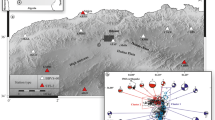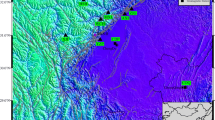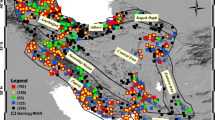Abstract
Temporal changes in site effects are obtained using the HVSR (horizontal-to-vertical spectral ratio) method and strong motion records after the M w 7.6 Chi-Chi earthquake, Taiwan. Seismic data recorded between 1995 and 2010 are used, comprising 3,708 data from 15 stations adjacent to the Chelungpu fault. Temporal fluctuations are determined by analyzing the site effect variation using a time–frequency variation (TFV) diagram based on these seismic data. Stations adjacent to the fault show significant disturbances in the resonance frequency at 16–26 Hz. Station TCU129 shows a 40% drop in fundamental frequency after the main shock, and a gradual return to the original state over nine years. For stations located farther from the fault zone, sudden changes in tectonic stress play a dominant role in temporal changes to the HVSR. An impact analysis of the directional factor confirms our finding that the proximity of the fault to seismic stations has the most influence on data.
Similar content being viewed by others
References
Barnaba C and Vuan A (2012), “Local Site Response in an Alpine Valley from Recorded Earthquakes and Ambient Noise Analysis,” Bulletin of the Seismological Society of America, 102: 2225–2231.
Chen KH, Furumura T, Rubinstein J, and Rau RJ (2011), “Observations of Changes in Waveform Character Induced by the 1999 M w7.6 Chi-Chi Earthquake,” Geophysical Research Letters, 38: L23302, DOI: 10.1029/2011GL049841.
Chuang SY, Chen HC, Ching KE, Rau RJ, and Hou CS (2008), “Crustal Deformation in Central Taiwan before and after the 1999 Chi-Chi Earthquake from GPS Observations, 1996–2006,” Special Publication of the Central Geological Survey, 20: 63–80.
Gallipoli MR and Mucciarelli M (2009), “Comparison of Site Classification from VS30, VS10, and HVSR in Italy,” Bulletin of the Seismological Society of America, 99(1): 340–351, DOI: 10.1785/0120080083.
Lee SJ, Ma KF and Chen HW (2006), “Threedimensional Dense Strong Motion Waveform Inversion for the Rupture Process of the 1999 Chi-Chi, Taiwan, Earthquake,” Journal of Geophysical Research: Solid Earth, 111(B11): B11308, DOI: 10.1029/2005JB004097/abstract.
Lermo J and Chavezgarcia FJ (1993), “Site Effect Evaluation Using Spectral Ratios with Only one Station,” Bulletin of the Seismological Society of America, 83: 1574–1594.
Lin KC, Hu JC, Ching KE, Angelier J, Rau RJ, Yu SB, et al. (2010), “GPS Crustal Deformation, Strain Rate, and Seismic Activity after the 1999 Chi-Chi Earthquake in Taiwan,” Journal of Geophysical Research: Solid Earth, 115(B7): B07404, DOI: 10.1029/2009JB006417.
Lombardo G and Rigano R (2006), “Amplification of Ground Motion in Fault and Fracture Zones: Observations from the Tremestieri Fault, Mt. Etna (Italy),” Journal of Volcanology and Geothermal Research, 153:167–176.
Lombardo G and Rigano R (2007), “Local Seismic Response in Catania (Italy): A Test Area in the Northern Part of the Town,” Engineering Geology, 94: 38–49.
Moisidi M, Vallianatos F, Soupios P, and Kershaw S (2012), “Spatial Spectral Variations of Microtremors and Electrical Resistivity Tomography Surveys for Fault Determination in Southwestern Crete, Greece,” Journal of Geophysical Engineering, 9: 261–270.
Nakamura Y (1989), “A Method for Dynamic Characteristics Estimation of Subsurface Using Microtremors on the Ground Surface,” Quarterley Report of Railway Technical Research Institute, 30: 25–33.
Panzera F, Lombardo G, D'Amico S, and Galea P (2013), “Speedy Techniques to Evaluate Seismic Site Effects in Particular Geomorphologic Conditions: Faults, Cavities, Landslides and Topographic Irregularities,” Engineering Seismology, Geotechnical and Structural Earthquake Engineering, CH5, ISBN 978–953–51–1038–5.
Puglia R, Ditommaso R, Pacor F, Mucciarelli M, Luzi L, and Bianca M (2011), “Frequency Variation in Site Response as Observed from Strong Motion Data of the L'Aquila (2009) Seismic Sequence,” Bulletin of Earthquake Engineering, 9(3): 869–892, DOI: 10.1007/s10518-011-9266-2.
Rubinstein JL, Uchida N, and Beroza GC (2007) “Seismic Velocity Reductions Caused by the 2003 Tokachi-Oki earthquake,” Journal of Geophysical Research: Solid Earth, 112(B5): B05315, DOI: 10.1029/2006JB004440.
Sawazaki K, Sato H, Nakahara H, and Nishimura T (2009), “Time-lapse Changes of Seismic Velocity in the Shallow Ground Caused by Strong Ground Motion Shock of the 2000 Western-Tottori Earthquake, Japan, as Revealed from Coda Deconvolution Analysis,” Bulletin of the Seismological Society of America, 99: 352–366.
Sgarlato G, Lombardo G, and Rigano R (2011), “Evaluation of Seismic Site Response Nearby Underground Cavities Using Earthquake and Ambient Noise Recordings: A Case Study in Catania Area, Italy,” Engineering Geology, 122(3–4): 281–291.
Tsai YC (2006), “Impact of the Viscoelastic Relaxation Following the 1999 Chi-Chi, Taiwan, Earthquake,” Master Thesis, Department of Earth Sciences, Central University (NCU).
Wen KL, Peng HY, Tsai YB, and Chen KC (2001), “Why 1g Was Recorded at TCU129 Site during the 1999 Chi-Chi, Taiwan, Earthquake,” Bulletin of the Seismological Society of America, 91(5): 1255–1266, DOI: 10.1785/0120000707.
Wu C and Peng Z (2011) “Temporal Changes of Site Response during the 2011 M w 9.0 off the Pacific Coast of Tohoku Earthquake,” Earth and Planetary Science Letters, 63: 791–795.
Wu C, Peng Z, and Ben-Zion Y (2009), “Non-linearity and Temporal Changes of Fault Zone Site Response Associated with Strong Ground Motion,” Geophysical Journal International, 176(1): 265–278, DOI: 10.1111/j.1365-246X.2008.04005.x.
Yeh CT (2001), “Analysis of Nonlinear Soil Response During the Chi-Chi Earthquake Using Horizontalto-vertical Spectral Ratio Method,” Master Thesis, Graduate Insitute of Applied Geology, Central University (NCU).
Yu SB, Kuo LC, Hsu YJ, Su HH, Liu CC, Hou CS, Lee JF, Lai TC, Liu CC, Liu CL, Tseng TF, Tsai CS, and Shin TC (2001), “Preseismic Deformation and Coseismic Displacement Associated with 1999 Chi-Chi, Taiwan, Earthquake,” Bulletin of the Seismological Society of America, 91(5): 995–1012.
Author information
Authors and Affiliations
Corresponding author
Rights and permissions
About this article
Cite this article
Yu, TT., Wu, CS. & Cheng, YS. Detecting changes in long-period site responses after the M w 7.6 Chi-Chi earthquake, Taiwan, using strong motion records. Earthq. Eng. Eng. Vib. 14, 217–228 (2015). https://doi.org/10.1007/s11803-015-0018-1
Received:
Accepted:
Published:
Issue Date:
DOI: https://doi.org/10.1007/s11803-015-0018-1




